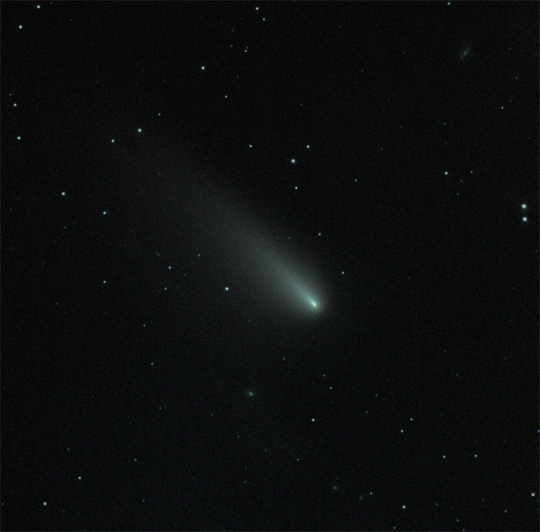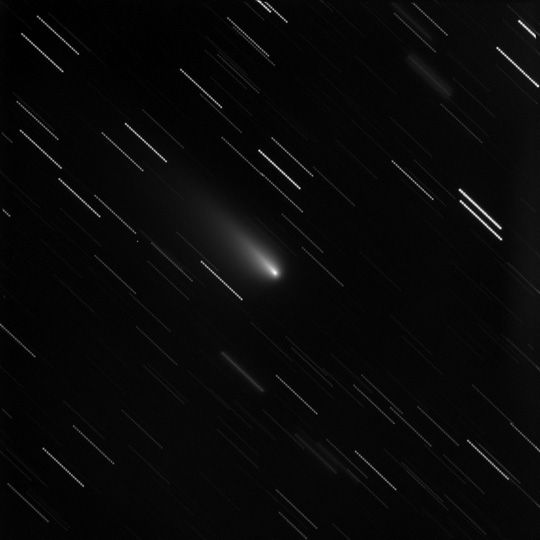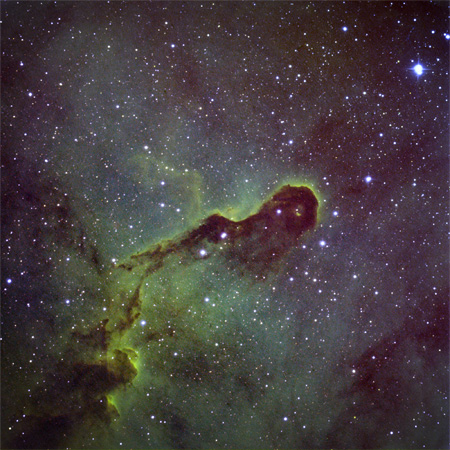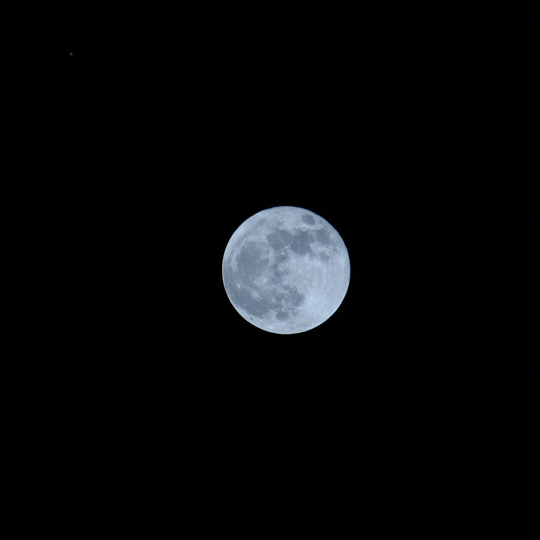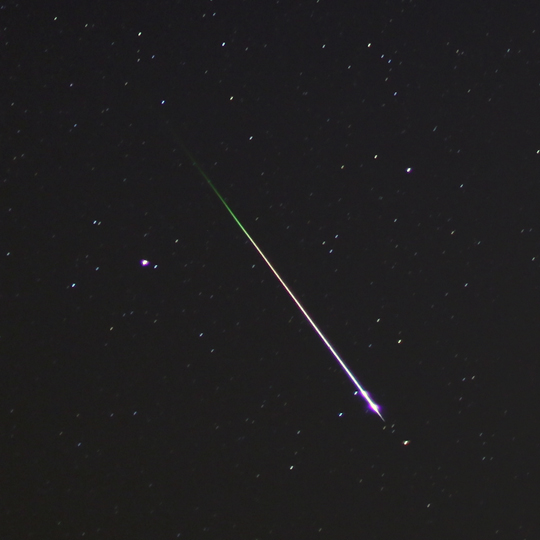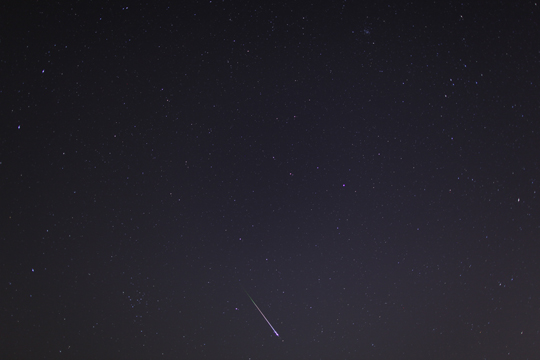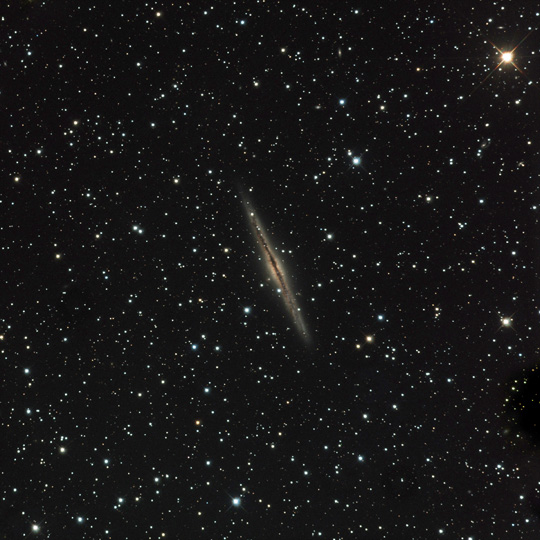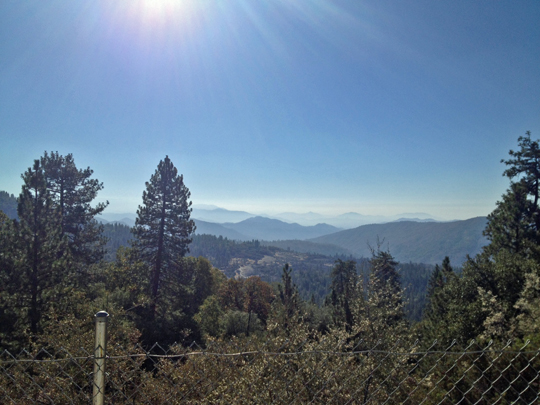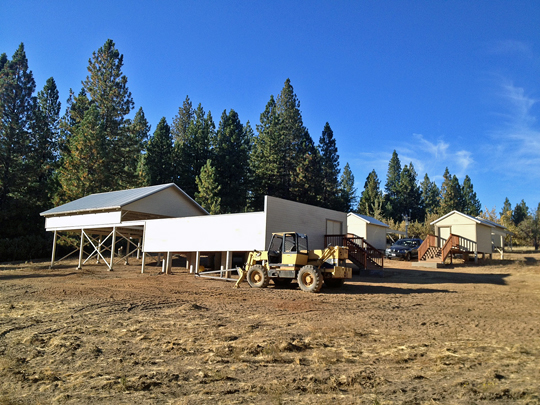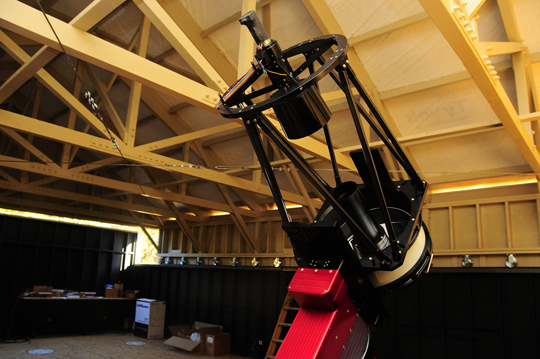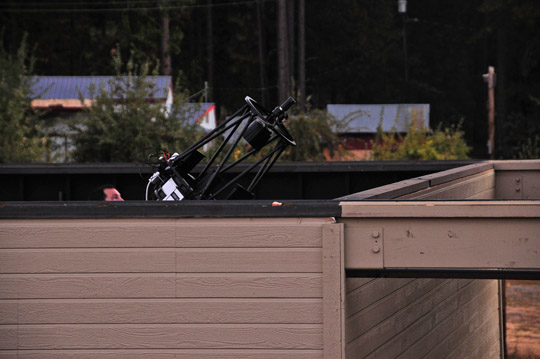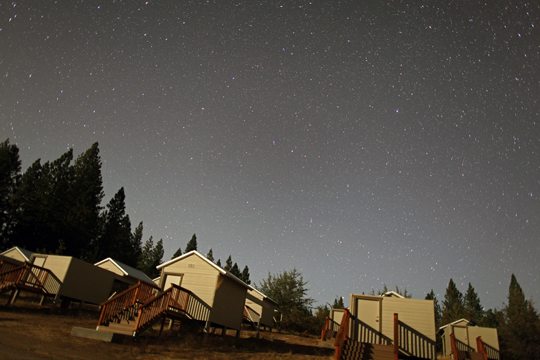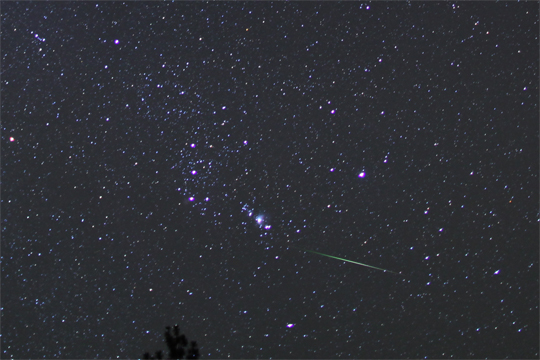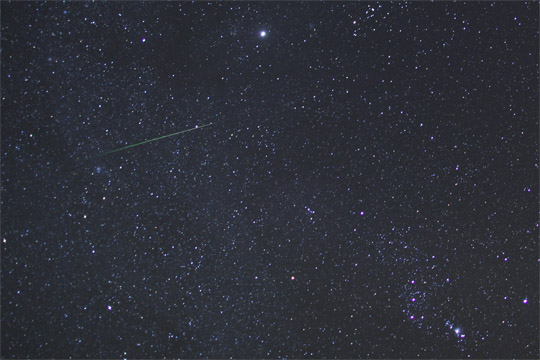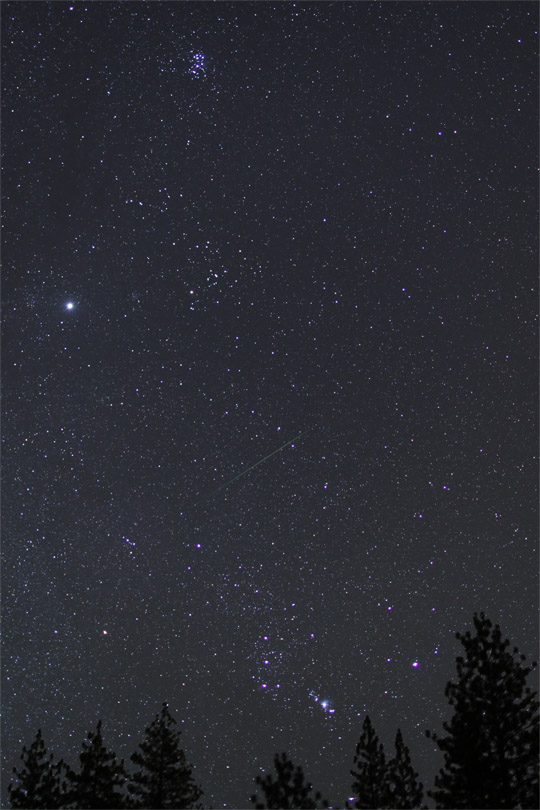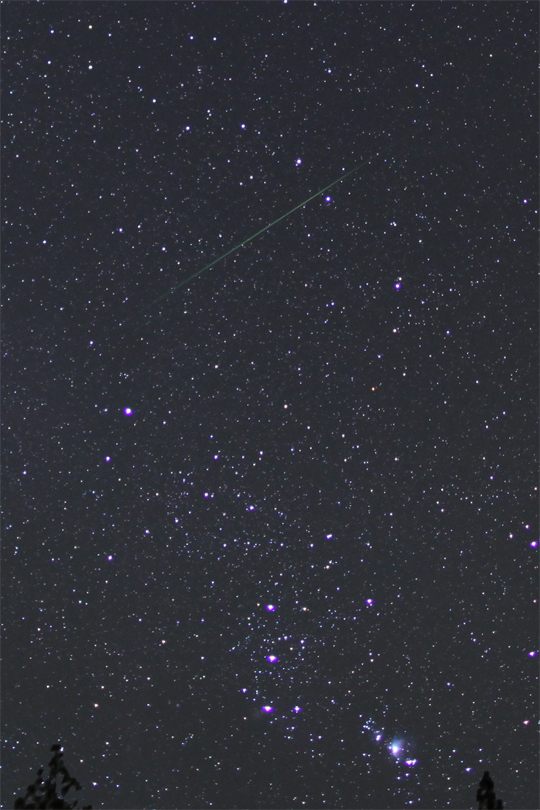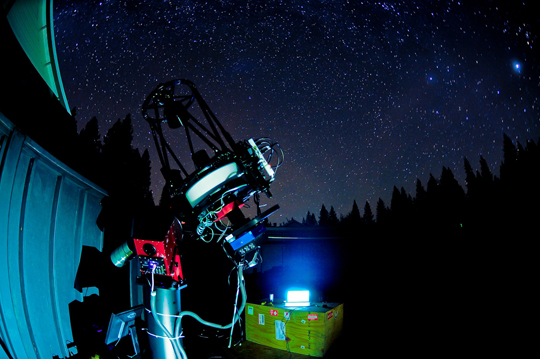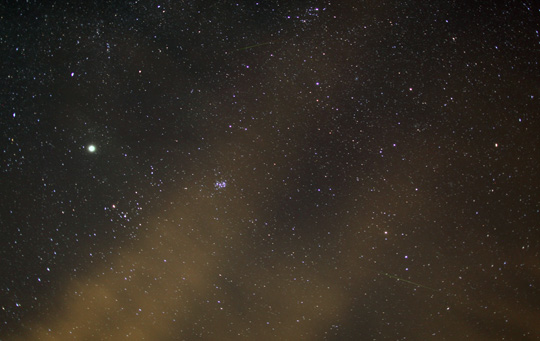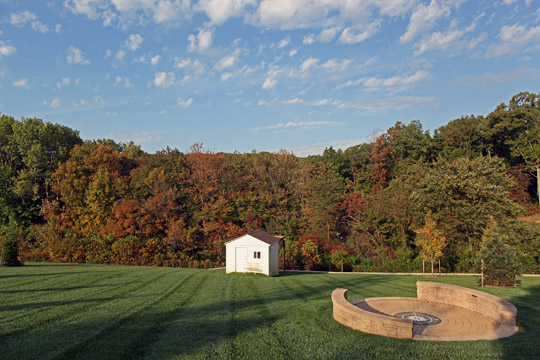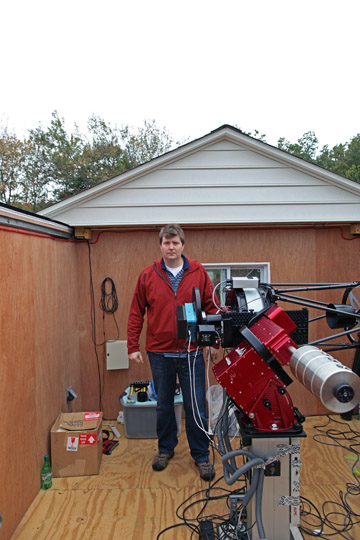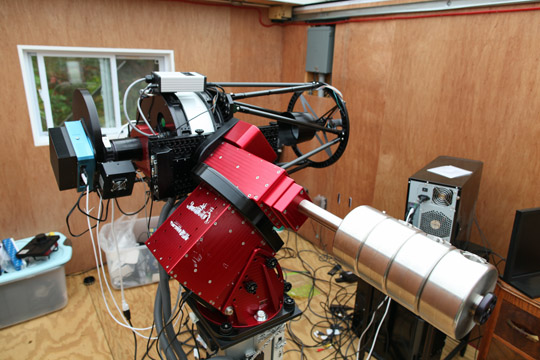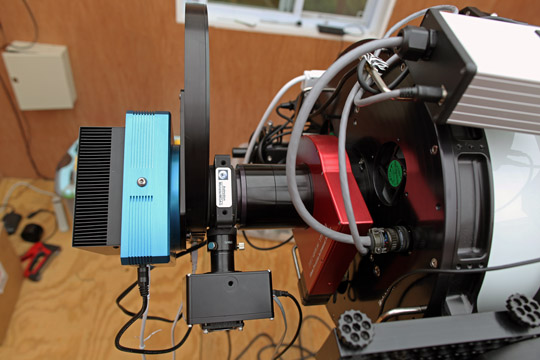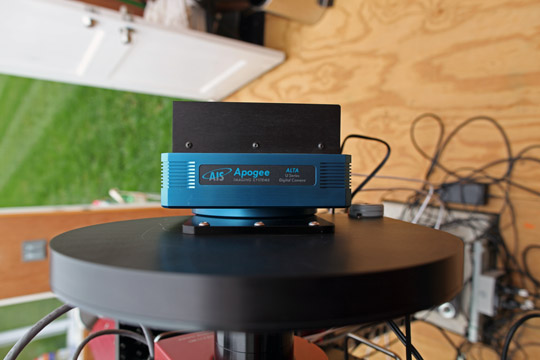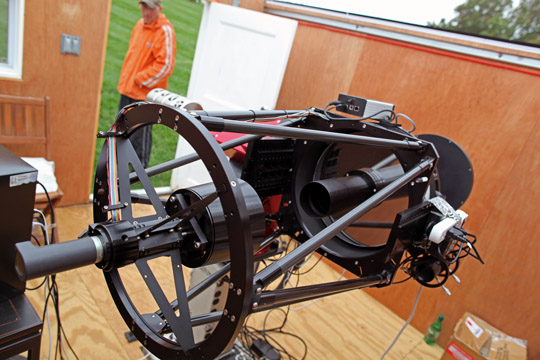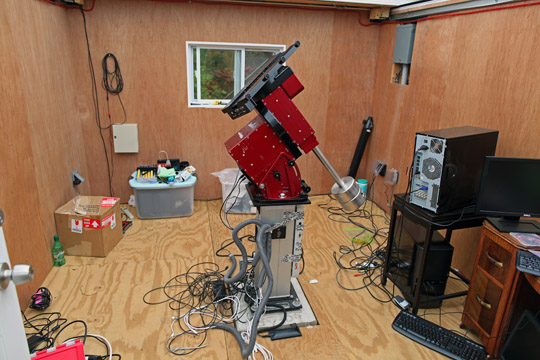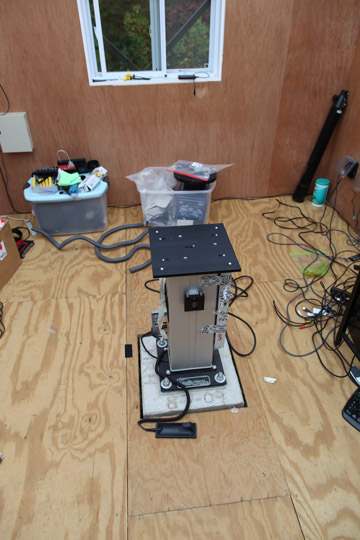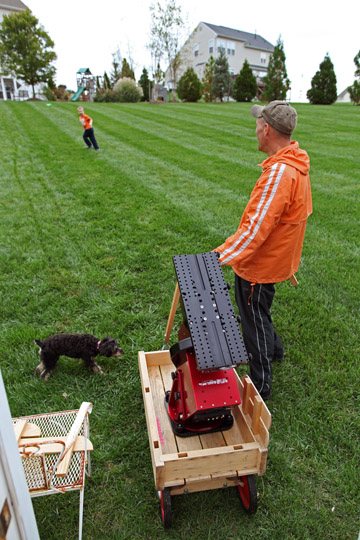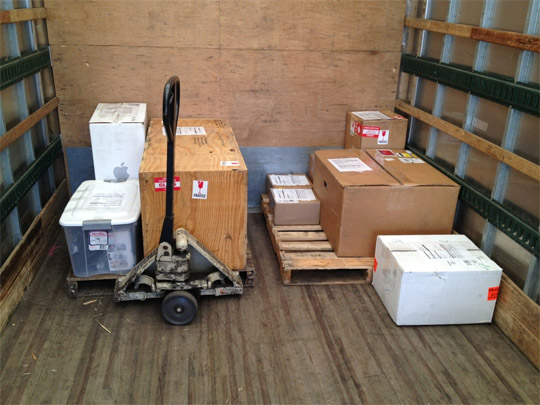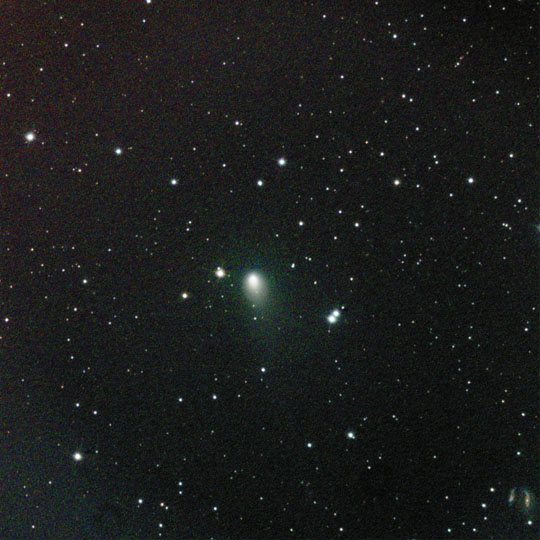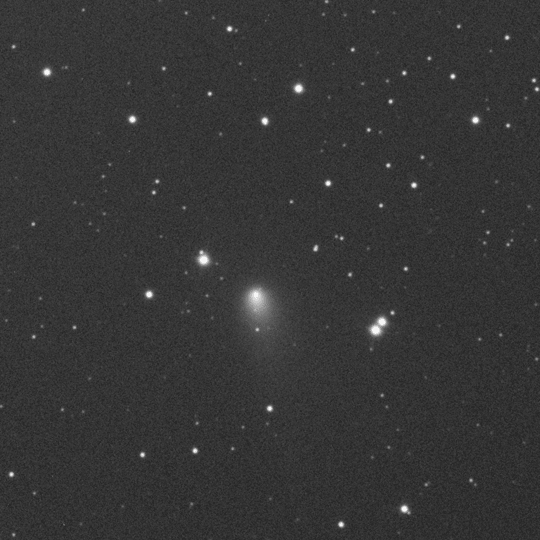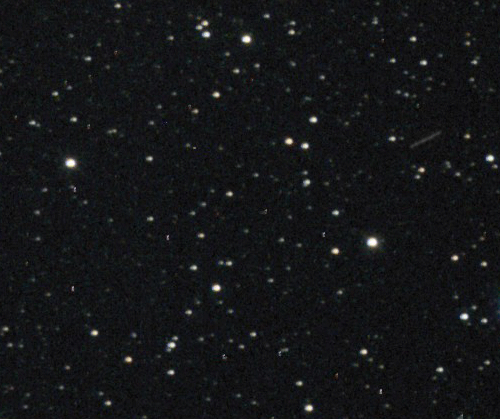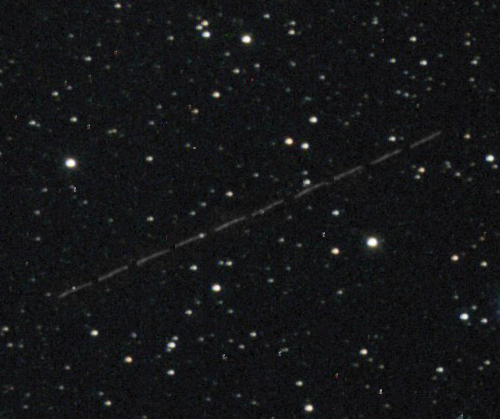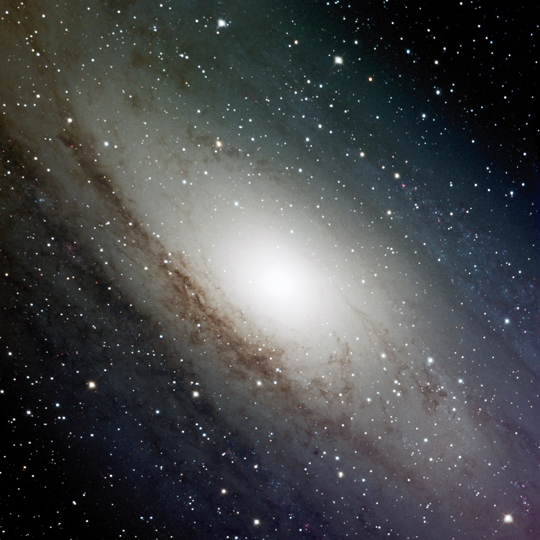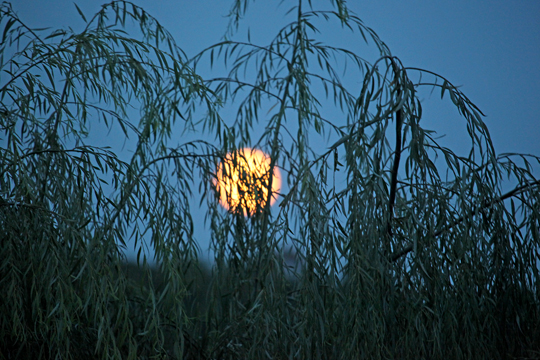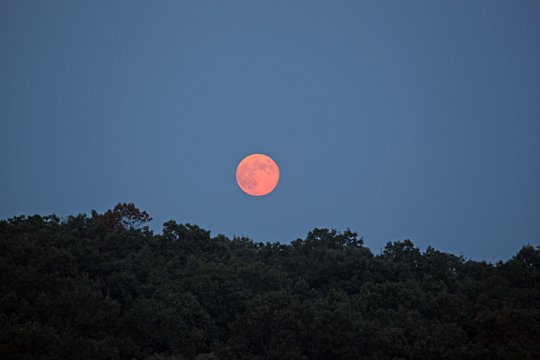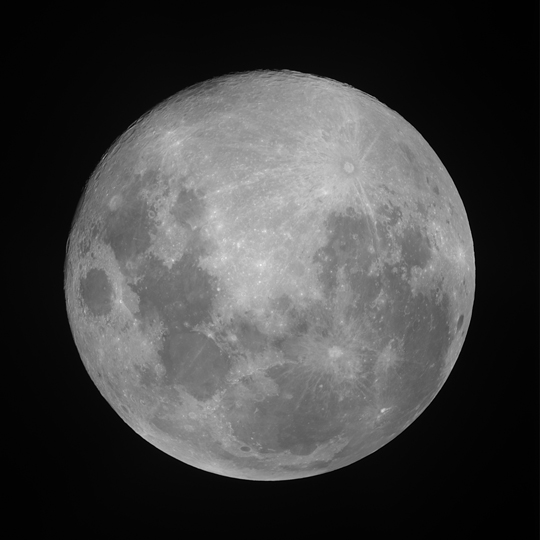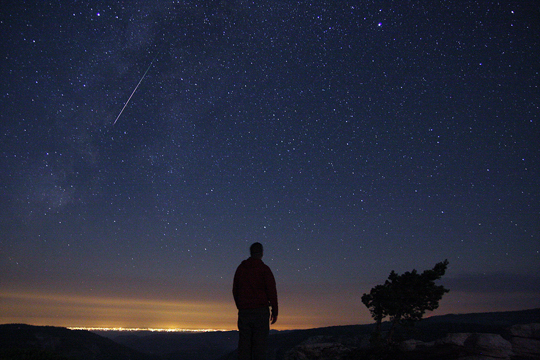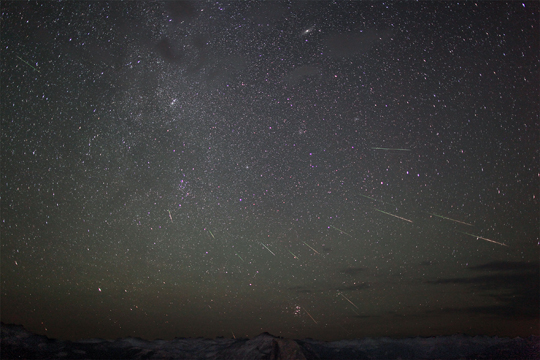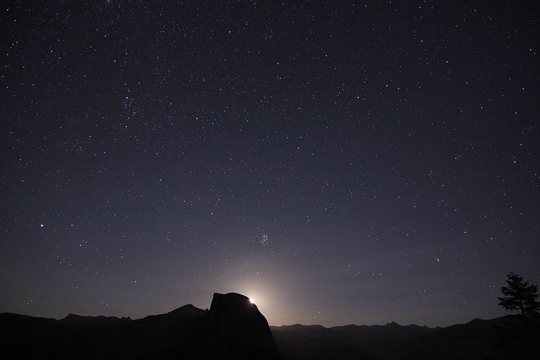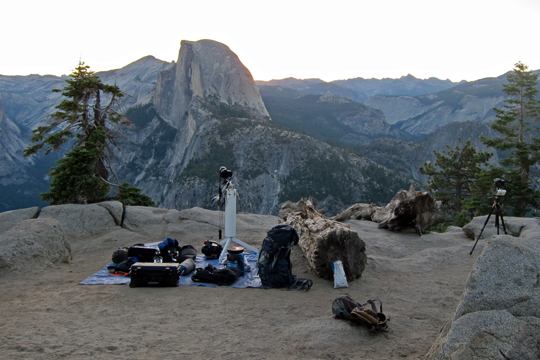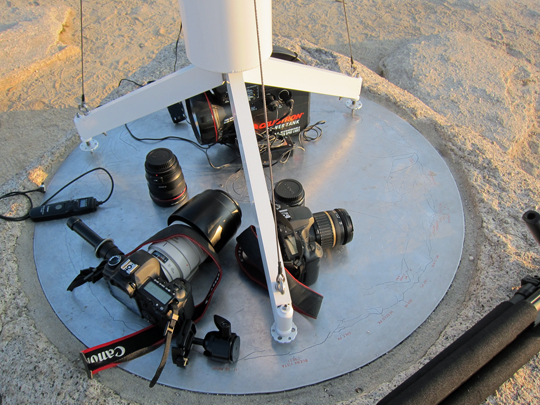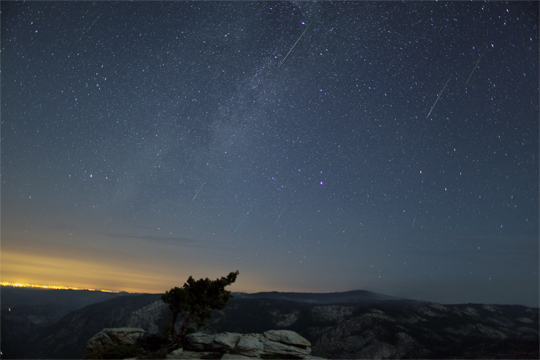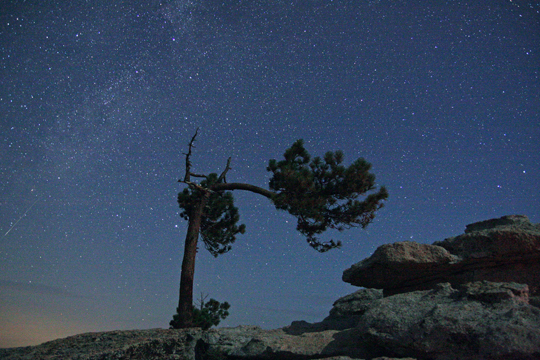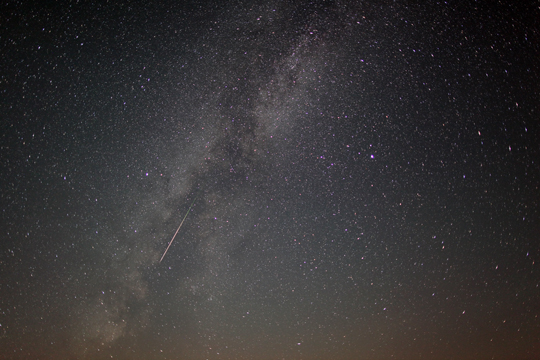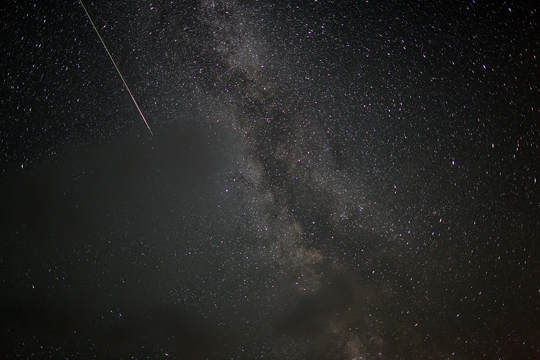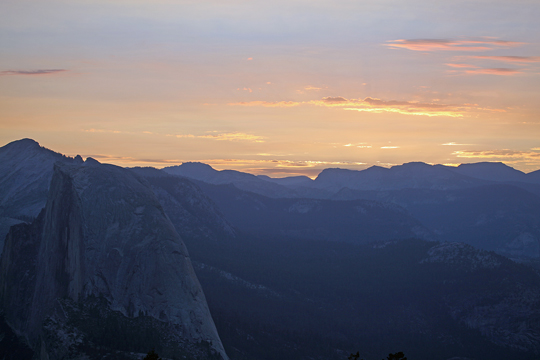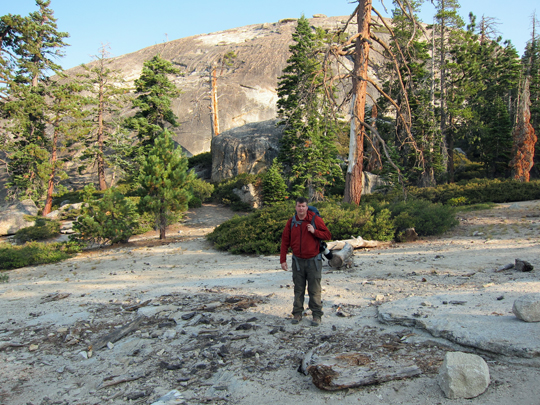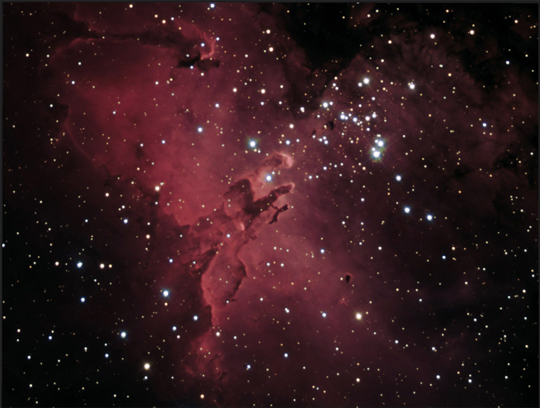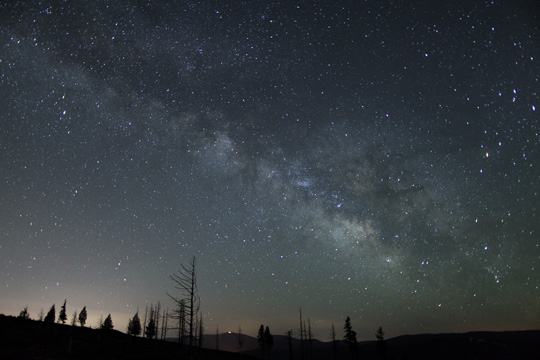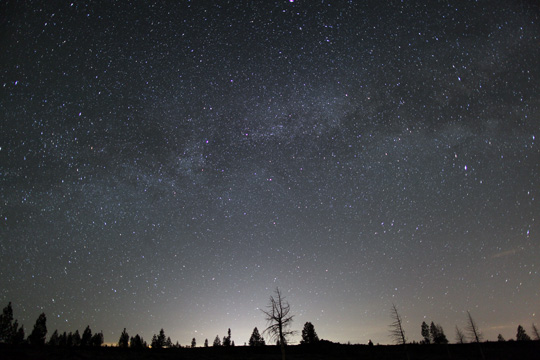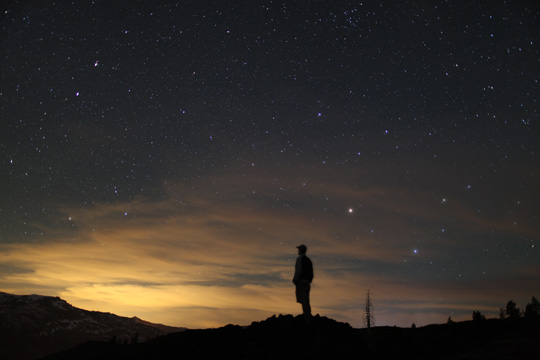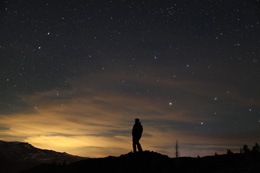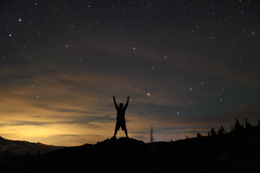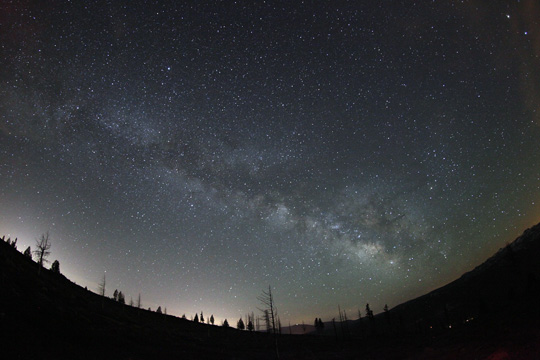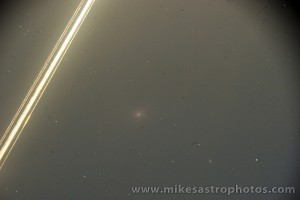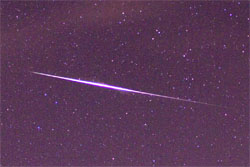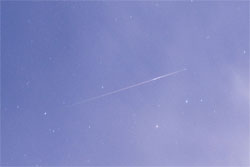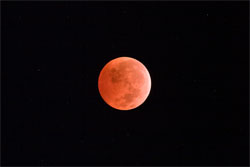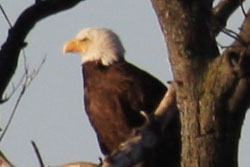Archive for 2012
Comet C/2012 K5 (LINEAR)
by Mike Hankey, under Comets & Meteors
Comet C/2012 K5 (LINEAR) was discovered by Lincoln Laboratory Near-Earth Asteroid Research project in May of 2012. The comet is just now starting to get bright (magnitude 10) and is in a convient location for night time viewing. I spent a few hours last night checking out the comet and taking some photos. Here’s a color photo of the comet taken with 20 minutes of luminous data and 1.5 minutes of RGB data (30 seconds each). The comet is moving fast against the stars which makes imaging it a bit of a challenge. The trick is to filter out all of the star trails and just stack the comet, and then combine that with an RGB picture of the star field. Here’s my first attempt at this method.
Without the extra processing to remove the trailing stars, the image looks like this.
This comet can be seen with a low powered telescope, binoculars, or even a DSLR camera. Its currently inside the big dipper the next couple of nights. Refer to the star map below for placement over the next few months.
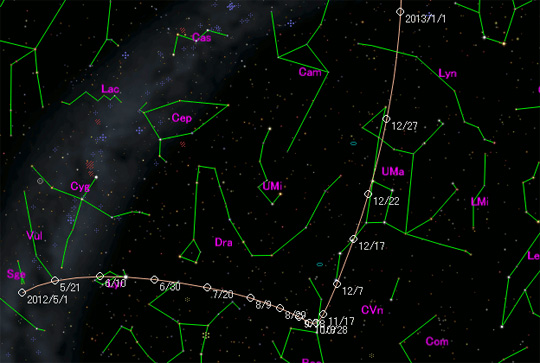
Star Map of Comet C/2012 K5
Star map courtesy of Seiichi Yoshida.
Elephant Trunk Nebula in Hubble Palette
by Mike Hankey, under Nebula
Here’s my first ever narrow band image using the Hubble pallet. This is only about a 3 hour exposure. I wanted to collect more data, but a multi-day storm has come through CA and there won’t be a clear night for about a week, so I figured I would get this done as best I could and consider it version 1. Here is a great tutorial on how to compose Hubble Palette images using data collected with Ha, Oii & Siii narrow band filters. I’ve gotten most of the bugs out of my system, but my tracking is still not 100%. I’m currently dealing with a 2 arc second guide error peak to peak, and I’d like to get that down to 1 arc second. Other than that, things are working pretty good.
Approximately 3,000 light years away, the Elephant Trunk Nebula is part of the emission nebula IC 1396. It was given this name as the gas cloud resembles the head and trunk of an elephant. While the entire nebula covers 5 degrees of the night sky, the trunk part of it is estimated to be 20 light years long.
Photo Details
NGC 891
Ha, Oiii, Sii @ 60x60x60 Minutes Each
Total exposure: 3 hours
Camera: Apogee U16M
Guider: SBIG 402 with MMOAG Off Axis Guider
Telescope: RCOS 14.5
Mount: Paramount ME
Location: Auberry, CA
Date: 11/27/2012, 11/28/2012
Software: The SkyX, MaximDL, FocusMax, CCDAutoPilot, CCDStack, Photoshop
Moon and Jupiter Conjunction
by Mike Hankey, under Planets
If you’re reading this and its still November 28th, go outside and look at the moon. The bright star in the upper left very close to the moon, is no star but the planet Jupiter. This celestial conjunction is a unique treat. In case you missed it, here’s a picture of the moon along with Jupiter taken with my DSLR and a telephoto lens.
Leonid Meteor Corrected: November Iota Draconids Meteor
by Mike Hankey, under Comets & Meteors
Update Dec 5, 2012 — After examining this meteor photo Bob Lunsford author of Meteors and How to Observer Them let me know that this is not actually a Leonid meteor, but rather a November Iota Draconids Meteor. Despite the fact that it occurred during the leonid meteor shower peak and actually appears inside the Constellation Leo, the meteor does not align with the Leo radiant, rather this meteor originates from the Draconid radiant.
I’ve been burning the candle at both ends, between astronomy and meteorite hunting not to mention my real job and home life. My wife went away for the weekend to visit with her family and I’ve been pulling Mr. Mom duty. Yes its tiring, but last night was the peak of the Leonids, the moon set early and there were no clouds. So I setup a camera on my balcony and went to bed early, but shot all night long. While reviewing the pics this morning, I was a little disappointed by the lack of meteors I had captured, that is until I came across this guy. I only caught 2 meteors the whole night, but it was worth it for this bright Leonid.
The picture above is a full resolution crop of just the meteor. Here is the full frame reduced in size.
Photo Details
Image taken with Canon 5d Mark II Camera and Canon 35mm f1.4 L USM EF Lens. Tripod mounted (no tracking) 25 second exposure @ ISO 400.
Galaxy NGC 891 – First Light at SRO
by Mike Hankey, under Galaxies
As expected I hit a few obstacles after leaving my scope in California at the Sierra Remote Observatory. The first was a crashing PC that somehow started acting up right after I left. I ended up replacing this and re-installing all the software. I’m glad I did though, because it hasn’t crashed since (knock knock). Once the computer was stable I worked with the guys at SRO to fix the collimation on the scope. They did a great job with this and I was able to get my first run of images this week. I was tweaking tracking paramaters and setup over a few nights and still have some kinks left to work out, but we are almost there. Here’s my first light image from SRO. Its no APOD, but not to shabby.
NGC 891 is considered an ‘edge-on’ spiral galaxy, which means from our perspective we can only see the side of it. The galactic bulge in the center of the disk is a classic sign of an edge on galaxy. At 30 million light years away, NGC 891 is one of the most famous edge-on spiral galaxies. Its also one of my favorite astrophotography targets. Here are some of my past images of NGC 891 – NGC 891 – December 3rd, 2011 and another shot of NGC 891 on February 7th, 2011.
Photo Details
NGC 891
RGB 60x60x60 Minutes Each
Total exposure: 3 hours
Camera: Apogee U16M
Guider: SBIG 402 with MMOAG Off Axis Guider
Telescope: RCOS 14.5
Mount: Paramount ME
Location: Auberry, CA
Date: 11/13/2012, 11/14/2012
Software: The SkyX, MaximDL, FocusMax, CCDAutoPilot, CCDStack, Photoshop
SRO Update – Mission Accomplished
by Mike Hankey, under Observatory
I flew out to Fresno CA this past Thursday night with the goal of getting my telescope equipment that I had shipped out the week before and setting it up at Sierra Remote Observatories (SRO). The day I flew out, a news story broke about a massive meteorite producing fireball that happened off the coast of California and was thought to have dropped meteorites west of San Francisco. This was certainly a sign that my mission was Universe approved!
I picked up my gear (515 lbs) at a warehouse in Fresno Friday morning, packed my rented SUV chock-a-block full without a space to spare and then drove up the mountains to the Observatory inside the Sierra National Forest. Here’s a picture of the view near SRO.
The site is literally amazing — better than Disney World. There are about a dozen single station roll-offs all lined up next to each other in two rows and then one massive roll-off, quite possibly the largest roll off observatory in the world. This would be my telescope’s new home. The building is big enough to house 10-12 scopes and an amazing feet of creativity and engineering skills. I was literally blown away by what these guys had created here.
My first day started around 8:00 am, I had a hard time finding the warehouse thanks to apple maps, but ended up finding it by 10:00 am (I had to use my brain). I was at the site by 12 and then spent the next 7-8 hours unpacking and physically setting up all of the equipment. I had everything mounted by 8pm, but had not connected any of the computer or software. I so wanted to stay the night tinkering and observing but I was literally exhausted. I would handle this phase much better after a night of rest, so we had dinner and then called it a night.
The next morning I left my rented cabin in Shaver Lake and drove back to the observatory. I spent the day setting up the computer cables, software, debugging problems, tying down the scope and camera wires, testing all of the movement and rotations so that wires wouldn’t get tangled up, collimating the scope and that kind of stuff. I had this all about done by 4:00 PM and then drove into town to grab some food and warmer clothes. It was the peak of the Orionid meteor shower and it would also be my first light on the scope at its new home and I would be staying up all night long!
I planned to do my polar alignment, final collimation and other software setups and then hopefully spend the rest of the night imaging. I ended up spending most of the night collimating and didn’t get through everything I needed to. I jumped back and forth between telescope tweaking and photographing the meteor shower. This was a really cool place to do some wide field astrophotography.
I was so busy with the scope setup, I barely had time to observe the shower and only saw a few meteors. In addition a storm was coming in and the humidity levels were up, causing my camera to fog up. I was only able to get a few meteor photos, but I’m really happy with them considering the level of attention they received.
Here’s a nice long Orionid Meteor from the 2012 peak.
Another positive sign from the Universe and my favorite picture of the night was this shot of a meteor right inside Orion’s bow. How cool is that!? For those who don’t know, Orion was the hunter and carried a bow (or in some interpretations a shield), this meteor looks like one of Orion’s arrows right before it is shot.
Here’s a zoomed in crop of just the Orion arrow meteor.
I tinkered with the scope until dawn, but still had more work to do before it would be ready for imaging. I worked on it through the day on Sunday but wouldn’t you know it clouds rolled in Sunday night and I couldn’t finish everything off. That’s ok though, now that I’m back I should be able to get the rest of the work done and be imaging in a week or so.
I left California Monday morning and headed to Tucson to pick up my slice of Lunar Meteorite, but that is another story.
A Couple Of Orionids 2012
by Mike Hankey, under Comets & Meteors
The Orionid Meteor Shower peaks this Saturday evening and Sunday morning! It was clear last night and I got some warm up practice time in. There wasn’t a lot of activity, but I did catch a pair of Orionid Meteors.
Telescope is on the move
by Mike Hankey, under Observatory
I first contacted Greg Morgan at Sierra Remote Observatories in November 2010. SRO is a telescope park nestled in the Sierra Nevada Mountains an hour east of Fresno, CA. The park is very similar to a data center in the computer world — its a secure location, providing power and internet connections at a super dark high elevation location. The mountains are above the smog layer of the atmosphere and block most of the clouds coming in from the Pacific leading to 280 clear nights per year. When I first contacted them they didn’t have any openings, but were just starting the process of building a new observatory building that would house 20+ telescopes. I put down a deposit and signed the lease and started building out the rig in my backyard. Over the next two years the guys at SRO walked me through the process and help me out immensely with learning the ropes of robotic astrophotography. I would ultimately control the telescope remotely via the internet from across the country, but this was quite an overwhelming project when first starting out. The observatory building process took longer than expected, but I put the time to good use and I really needed it. It literally took me all of this time to get all of the equipment and learn how to set it up and use it properly. I had finally gotten to the point where everything was working perfectly just a few weeks ago. They just finished the observatory in California and I had to tear down my astro-rig and ship it 2000 miles across the country. It shipped out yesterday on a freight truck. I will fly out to California next weekend and if all goes well I will be setting everything up next Friday and Saturday night during the peak of the Orionid Meteor Shower!
Here’s a picture of my observatory in Freeland, Maryland. I love the fall colors this time of year.
Here’s a picture of me with my scope right before we tore it down. I’m literally about ready to cry.
This is an amazing bunch of hardware.
The imaging train starts with a 360 degree rotator and field flattener, some extension tubes, an Astrodon MMOAG (Monster Manual Off Axis Guider), an SBIG 402 guide camera, a 10 position color filter wheel and then the Apogee U16M full format CCD camera.
The Apogee CCD camera is super cooled with a huge CCD chip!
Front view of RCOS with 14.5″ primary mirror.
Paramount ME German Equatorial Mount looking sad and lonely without the scope.
And finally all that was left behind…
We wheeled the Paramount up the hill and into the garage.
Packed everything up and put it on the truck yesterday. Note I do not use an apple computer for controlling the observatory telescope, i just had the box lying around and used it to pack my PC.
Comet 168P/Hergenrother
by Mike Hankey, under Comets & Meteors
Here’s a quick photo of Comet 168P/Hergenrother. This comet just reached its perihelion (closest point in orbit) on 1 October 2012. The photo below was created with a 1 minute exposure of RGB and 2 minutes of Luminance. There’s a good bit of noise in this image, but I figured out a bunch of tricks for taking and processing comet images while I was shooting this series. It was a productive session and my next round of comet photos should be much better. There’s a few tricks to photographing comets well (just like everything) and I look forward to shooting this guy again before he travels too far away. Check out the pair of faint distant galaxies in the lower right corner.
And here’s an animation of 10 frames of the comet. Each exposure is 30 seconds and there is an aproximate 300 second break in between each frame.
Photo Details
Comet 168P/Hergenrother
RGB 60 seconds 120 seconds Lum
Total exposure 2 hours 30 minutes
Camera: Apogee U16M
Guider: SBIG 402 with MMOAG Off Axis Guider
Telescope: RCOS 14.5
Mount: Paramount ME
Location: Freeland MD
Date: 10/6/2012
Software: The SkyX, MaximDL, FocusMax, CCDAutoPilot, CCDStack, Photoshop
Potentially Hazardous Asteroid – 2012 QG42
by Mike Hankey, under Comets & Meteors
Near Earth Asteroid, 2012 QG42 was discovered on August 26th and will be passing Earth tonight, Thursday September 13th, 2012. Moving at 7 miles per second this asteroid is estimated to be 625 to 1,400 feet long. I was able to acquire the target last night and take a few pictures. Here’s an animation of 10 frames of the asteroid. Each frame is a 60 second exposure.
Here is a composite image of the asteroid over the 10 minute period I was photographing it.
High Resolution Andromeda Galaxy – Messier 31
by Mike Hankey, under Galaxies
The Andromeda Galaxy has been one of my favorite pursuits since I started with astrophotography. It took me a while to figure out how to shoot it and each telescope you use reveals different things about the galaxy. I took this photo of Andromeda Friday night using a 14.5 inch RC and full format CCD. Andromeda is still too big to fit completely in this field of view, but I think we are getting about 75% of it. For reference, this is the same setup I used on the blue moon, so yes, Andromeda is bigger than the full moon in the night sky. Its just dimmer and harder to see with the naked eye. Imagine what it would be like to look up in the sky and see something like this.
Click the picture above for a [2400×2400] version or download a super high res [3700×3700] version of Andromeda here.
For comparison purposes, here are some past photos I’ve taken of Andromeda: Andromeda with a FLT 98 wide field telescope and SBIG ST8300 CCD in September 2011, Andromeda with FLT 98 and DSLR Camera in September 2010, the first picture I ever took of Andromeda with a Celestron CPC1100 and DSLR in January 2010 and of course the telescopic Bolide with Andromeda picture from July 2009.
Photo Details
Messier 31 – The Great Andromeda Galaxy
RGB 50X50X50 Minutes Each
Total exposure 2 hours 30 minutes
Camera: Apogee U16M
Guider: SBIG 402 with MMOAG Off Axis Guider
Telescope: RCOS 14.5
Mount: Paramount ME
Location: Freeland MD
Date: 9/7/2012
Software: The SkyX, MaximDL, FocusMax, CCDAutoPilot, CCDStack, Photoshop
here’s a zoomify version that is fun to play around with. Click the image to zoom in and the icons to control. Full screen mode is pretty cool.
Blue Moon
by Mike Hankey, under Lunar
August 31st, 2012 hosted the last Blue Moon we will see in a while.
As you probably already know a Blue Moon is not really blue. Its just the name we give for the moon when the full phase occurs twice in one month. This is considered a somewhat rare occurrence (not really in astronomical terms) and the next one won’t happen until 2015.
A few hours after moon rise, I spotted it with my telescope and took some high resolution photos. After stacking and processing I was pleased with the results.
Click the following link to download a super high resolution photo of the moon 4000×4000! Great for desktop wallpaper.
To create this high res picture of the moon, I took 50 exposures using a full format CCD camera with a H-alpha filter. The H-alpha filter cuts down on the light so much you can capture the moon images without over exposing (great trick). I then aligned and stacked the 50 images in Registax. This process improved the focus and clarity of the image by 10x! I really like this method of Lunar photography. Its simple, fast and easy and the images turn out great.
Perseid Meteor Shower – Yosemite National Park 2012
by Mike Hankey, under Comets & Meteors
I flew out to Fresno California to observe the Perseid meteor shower peak with Brendan Fallon my old friend, college roommate and meteorite hunting companion. We made it to the Yosemite National Park by early afternoon Friday, checked out the valley and scoped out possible locations for observing and photographing the meteor shower. Later in the day, we worked our way up to glacier point to observe the shower the night before the peak.
Glacier point is known as an astronomers hangout and many of the rangers recommended it to us as the place to be. I was surprised by how many people where there to watch the shower Everyone was talking about the shower and really excited about it . The San Jose Astronomical Society was hosting a star party on the ridge and over 100 people where there to see the show. We found a little area outside the fences on the edge of Glacier Point and setup our equipment with intentions of staying there all night. Camping is not allowed at attractions like Glacier Point but staying there all night, so long as you’re not sleeping or pitching a tent is totally fine. We were all setup a little before sunset and shot the skies with two cameras the entire night.
I spent most of the night fiddling with the cameras and had less time to relax and observe the shower, but Brendan was able to kick back and counted over 100 meteors the first night. I was not keeping a good count, being distracted by technical devices, but registered about 50-60 meteors. We both stayed up the entire night, and as celestial fortune would have it, on this night and only this night the moon, the Pleiades, Jupiter, Venus and the Sun would all rise over half dome. We were in the perfect location to watch all of this along with thousands of shooting stars all over the place. It was amazing.
After the sun rose around 7:00 AM we packed up our gear and slept for the rest of the day at a hotel an hour away from the park.
On Saturday, we made our way back to Yosemite by 7:00 PM and headed straight for Sentinel Dome. The top of the dome is about an hour hike from the parking lot and we each had packs filled with camera equipment and camping gear. At the peak of the dome in the center of the space, there was a big rock with a leveled metal compass in the middle. It was the perfect perch for my portable astrotech pier and tracking mount.
I was so amped to be on top of Sentinel Dome at 8,100 feet above sea level with 360 degree views of the entire park. It was amazing! After spending a night on Sentinel Dome I am convinced this is the BEST place on the planet to observe a meteor shower.
Every landscape view was breath taking, the skies were as dark as I’ve ever seen and there were meteors everywhere every minute. What else could you ask for?
I was much better about my counting this night and we played a counting game together, competing to see who would observe more meteors. Each time one of us saw a meteor we needed to say our count out-loud followed by the other persons count. It was a competition the entire night and helped keep us awake, alert and engaged in the shower. For the night of the peak I was able to count 250 meteors and Brendan counted 246.
Sentinel Dome is harder to get to than Glacier Point and we thought we would have the whole place to ourselves, especially since no-one was there after sun-set, but believe it or not throughout the night, several parties arrived at the dome after dark. Some getting there as late as two or three in the morning. I was again impressed with how many people who were interested in the shower and dedicated enough to make it out. We all shared a common bond watching the shower together from one of the highest points in Yosemite park.
That morning we watched the sun rise again and then hiked back to our car.
We were both exhausted and sleep deprived but still wide awake and pumped up from the adrenaline of the park, the meteors and the observing experience.
To date, this is the very best meteor observing experience I have ever had and I am convinced Yosemite and specifically Sentinel Dome is the best meteor observing location in the world for viewing the Perseid Meteor Shower.
Messier 16 – The Eagle Nebula
by Mike Hankey, under Nebula
Here’s a recent long exposure photo of the great Eagle Nebula.
There’s a lot more detail in this picture compared to this wide field shot of the Eagle Nebula I took about the same time last year. A years experience and a big optics upgrade can make quite a difference in magnification and photo quality.
This is the first image I’ve taken since March and the first serious chunk of time spent on my scope since then as well. I attribute the astro-hiatus to a combination of bad weather and the new Sutters Mill Meteorite fall. When I got back to the scope, I was feeling renewed and I wanted to tackle all of the tech problems I was having the last time around. I worked on this picture over a series of nights making corrections to the setup as I went along. I ended up throwing out multiple runs due to poor quality, but in the process was able fix quite a few glitches in my system. Over this period I
- re-placed and re-setup my PC in order to fix a nasty crashing issue, upgrading from windows XP to a newer box and win7 in the process
- re-installed/reconfigured all astronomy software
- re-collimated primary mirror
- fixed a sticking secondary focuser (hopefully for good)
- tweaked the polar alignment
- worked out all of the kinks in CCDAP except for one
So the last problem that plagues me is recovering a CCDAP session after the meridian flip. Once I figure that out, I will have completed my training with CCDAP and should be able to execute automated astrophotography runs while I am sleeping, which is an amazing feat and something I’ve been looking forward to for quite some time. It will have taken me nearly a year to setup, learn to use, tweak and refine this hardware and software to get it to the point that it is working perfectly. In less than 1-2 months I will need to tear it all down, ship it across the country and set it all up again in a remote observatory in California. Fortunately, the setup the second time around won’t be as hard.
Photo Details
Messier 16 – The Eagle Nebula
RRGB 80X80X60X60 Minutes Each
Total exposure 3 hours 20 minutes
Camera: SBIG ST8300
Guider: SBIG 402 with MMOAG Off Axis Guider
Telescope: RCOS 14.5
Mount: Paramount ME
Location: Freeland MD
Date: 6/25, 6/26
Software: The SkyX, CCDSoft, FocusMax, CCDAutoPilot, CCDStack, Photoshop
Milkyway From Truckee Calforinia
by Mike Hankey, under Stars
After the eclipse we left Lake Tahoe and went over to my friend Jose’s house in Truckee California. He was nice enough to take us to a remote location in Truckee on the top of a mountain. We had to hike for about 15 minutes through the dark and wilderness before we got to a clearing near the peak. It was worth the walk though. No moon, high elevation and dark skies made for some nice Milkway Photos.
In the picture below, the glow behind the tree in the center is the city light from Reno, NV.
There was a big boulder that one of the guys climbed up on. I thought it would make a cool shot so I told him to stand still.
Then the other guys gave it a try.
The skies in truckee are the nicest I’ve ever seen.
This observing and photography session was a great way to end our solar eclipse day. I’m very thankful to have had this opportunity and to have met Jose while meteorite hunting in Coloma, CA. I really appreciate Jose taking me out in the middle of the night to a remote location to take these pictures.
